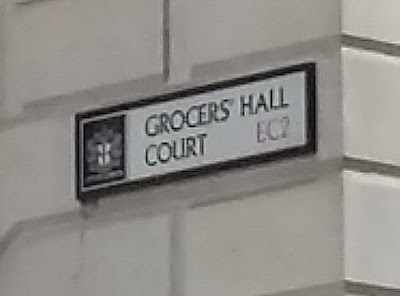Jennifer and I just stayed in this area for day ..
Walking with the map and then maybe taking a detour ,
here and there..!!
You definitely need to look up and down here.
Started out at Monument and walked the dotted line
with detours ..
Cheapside takes its name from ‘chepe’, a Saxon word for a market.
The street connected the southern end of the Roman Watling Street with the main City settlement to its east and its alignment was dictated by a convenient bridging point across the (now subterranean) River Walbrook.
The earliest Ashkenazi synagogue constructed in London after the return of Jews to England in the 17th century was built about 1690 at Duke's Place, north of Aldgate. In 1696-7, the synagogue also acquired a burial ground, at Alderney Road.
Love the OLD and NEW

on
The Bank of England,
Prince's Street / Lothbury, EC2
The statue is by Charles Wheeler, who produced several works for the rebuilt Bank, of which Ariel is the most highly regarded and gained the Royal British Society of Sculptors’ medal for the best work of the year in 1937
The statue is by Charles Wheeler, who produced several works for the rebuilt Bank, of which Ariel is the most highly regarded and gained the Royal British Society of Sculptors’ medal for the best work of the year in 1937
This is taken from Tivoli Corner
(It took me ages to find where I took the photo from, wasn't going to give up!!)
I love this photo.
The map below shows Founders Court..
Below is just a little piece of the history of the Hall..
more in the link above.
(taken from the internet)
more in the link above.
(taken from the internet)
The Founders' Company began its existence as one of the early medieval "guilds" or associations formed by members of various crafts or trades in the City of London. Their main purposes were to defend the craft against unfair competition, to assist its members in their work, to help those in distress and to promote and control education.
Founders were workers in brass and brass alloys or tinplate known as "Iatten" or "laton", producing small cast articles such as candlesticks and pots and pans. Their workshops were situated in and around Lothbury, a street that still exists under that name.
From 1508 to 1987 their parish church was St. Margaret Lothbury. Before that time, the Founders were associated with the church of St. Lawrence Jewry, and indeed there is evidence to suggest that the medieval guild grew out of a parish fraternity known as the Brotherhood of St. Clement, based on the church of St. Lawrence Jewry, which served the spiritual and material needs of its members.
Founders were workers in brass and brass alloys or tinplate known as "Iatten" or "laton", producing small cast articles such as candlesticks and pots and pans. Their workshops were situated in and around Lothbury, a street that still exists under that name.
From 1508 to 1987 their parish church was St. Margaret Lothbury. Before that time, the Founders were associated with the church of St. Lawrence Jewry, and indeed there is evidence to suggest that the medieval guild grew out of a parish fraternity known as the Brotherhood of St. Clement, based on the church of St. Lawrence Jewry, which served the spiritual and material needs of its members.
Cheap is a small ward in the City of London.
It stretches west to east from King Edward Street, the border with Farringdon
Within ward, to Old Jewry, which adjoins Walbrook; and north to south from Gresham Street, the border with Aldersgate and Bassishaw wards, to Cheapside, the boundary with Cordwainer and Bread Street wards.
The name Cheap derives from the Old English word "chep" for "market"
St Lawrence Jewry next Guildhall is a Church of England guild church in the City of London on Gresham Street, next to Guildhall. It was destroyed in the Great Fire of London in 1666, and rebuilt to the designs of Sir Christopher Wren
St Lawrence Jewry is the official church of the Lord Mayor of London and the City of London Corporation and stands in the Yard of the Guildhall.
This is the St George Window in the Commonwealth Chapel
The church is regularly open weekdays and for special events such as an annual music festival in August offering daily lunchtime concerts. It is well worth visiting, especially since you can easily combine a visit to St Lawrence with a visit to the Guildhall,
its excellent art gallery, and the Roman amphitheatre discovered under Guildhall Yard during building of the Gallery
I do hope you have enjoyed this small tour.. I do have a little
bit more to write about. Jennifer and I did this little tour in a DAY!!
All information is from the web - and links included.
♥♥♥♥♥♥♥♥


















I have enjoyed your small tour. You have shown me so many things that are new to me :-)
ReplyDeleteThanks Anne for another great tour in London, I have learnt more about London in your last few blogs than I have learnt in my life time. Hope that everything gets sorted out for you. Take care Diane and Nigel xox
ReplyDelete